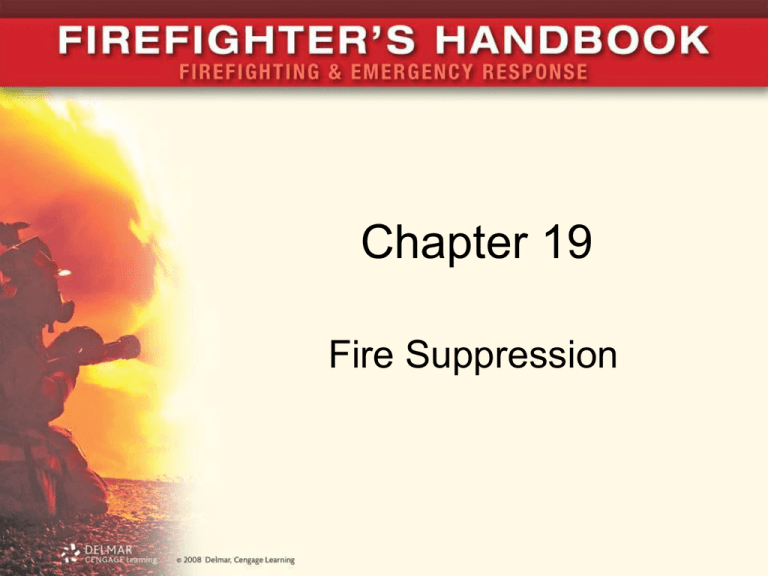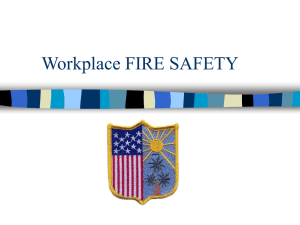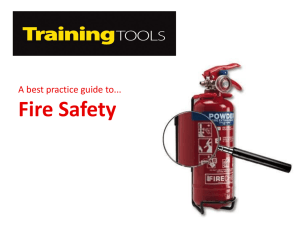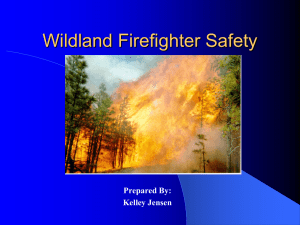Chapter 19
advertisement

Chapter 19 Fire Suppression Introduction • This chapter covers: – Putting into action the techniques and methods discussed thus far – Common types of fires and some common techniques – Common elements of fire control – Tactical considerations 19.2 Elements of Fire Control • Know the basic principles involved in processes that create and sustain fire • Lower the losses and risks: – Arrive on the scene quickly – Bring all your knowledge 19.3 Structural Fire Components and Considerations • Many factors must be taken into consideration: – – – – Length of time fire has been burning Building construction materials Occupancy type and contents Resources available 19.4 Figure 19-1 The old and new ways of visualizing the combustion process, the fire triangle and the fire tetrahedron. 19.5 Ground Cover Fire Components and Considerations • Wildland fire triangle: – Weather • Given similar fuels and topography, fires burn radically differently in different weather conditions – Fuel • Two main variables: rate of spread and fire intensity – Topography • Steepness of slope, drainages, ridges and saddles all critical to fire behavior 19.6 Figure 19-5 The wildland fire triangle differs from the structural fire triangle. 19.7 Figure 19-6 The components that make up the weather side of the wildland fire triangle. 19.8 Figure 19-7 The components that make up the fuels side of the wildland fire triangle. 19.9 Figure 19-10 The components that make up the topography side of the wildland fire triangle. 19.10 Vehicular Fire Components and Considerations • Number of variables: – Avoid standing in front of bumper after it is heated – Any fuel leak in engine compartment can ignite quickly – Recognize electric vehicles – Primary dangers in passenger compartment are materials used in construction – Use care around air bags: chance of discharge – Trunk used for storage of unknown materials – Underside fuel storage area may be leaking raw fuel 19.11 Flammable Liquids Fire Components and Considerations • Each flammable liquid has its own specifications – Solubility – Polar solvents – Specific gravity • Specifications affect burning characteristics and extinguishment • Knowing characteristics of a material provides margin of safety and ability to mitigate the hazard 19.12 Flammable Gas Fire Components and Considerations • Can be grouped with flammable liquids • Understand hazards associated with gases • Properties: – Flammable range – Vapor density – Toxicity 19.13 Process of Fire Extinguishment • Number of steps must be taken: – Plan of attack – Apply plan of action quickly, efficiently, safely – Indirect attack – Combination attack • Goal is to save property – Not enough water: fire will not be extinguished – Too much water: water damage may exceed fire damage 19.14 Figure 19-17 The indirect attack has the firefighters applying a 30-degree fog into the upper heat layer of the fire in order to create a steam that will extinguish the fire. 19.15 Figure 19-21 If the line selected does not match the size needed, the fire will burn longer and hotter and can jeopardize the operation. 19.16 Proper Stream Selection • Sufficient water must be applied • Factors: – – – – – Proper stream type Stream size Placement of fire stream Nozzle type Mobility of stream 19.17 Table 19-1 Hose Stream Characteristics 19.18 Figure 19-22 The first line pulled should be positioned between the potential victims and the fire. 19.19 Tactical Considerations • Priorities: RECEO • Incident Command System (ICS) • Tactical objectives: – – – – – – – Mental preparation All factors considered upon arrival Choose mode of attack and call for attack Exposure Confinement and ventilation Extinguishment Overhaul 19.20 Figure 19-28 Radiant heat is the main cause of exposure fires within short distances. Radiant heat will travel in straight lines from the heat source to nearby objects. 19.21 Figure 19-29 Fires most commonly should be attacked from their unburned side, pushing the products of combustion away from unburned materials and areas. 19.22 Table 19-2 Fireground Factors 19.23 Residential Occupancies • Generic considerations: – – – – – – – Scan the scene Order of attack Rescue occupants Exposure control Ventilation Extinguishment and overhaul Housing and clothing for occupants 19.24 Table 19-3 Rescue Factors 19.25 Business and Mercantile Occupancies • Fought differently than residential fires – Depending on time of day, life hazard for victims not as great – Hazards to firefighter can be greater – First-in engine goes to front of building – Second-in engine has numerous options based on condition of fire • Injuries come from falls and building collapse • Hazards associated with products manufactured 19.26 Multistory Occupancies • First-in unit goes to control room • Communication is extremely important • Gather in stairwell prior to deploying on fire floor • First-in truck goes into ventilation mode • Other arriving units fill important operational positions 19.27 Figure 19-41 Firefighters must only use elevators that are secured so that accidental fire exposure will never occur. 19.28 Figure 19-42 The high-rise fire is usually attacked from the stairwells. Laying hose up from the floor below the fire floor will give the firefighting team a safer and more efficient operation. 19.29 Below-Ground Structures or Basements • Some of the hardest fires to fight – Highest temperature is at entry point – Difficult to ventilate • First-in engine company goal is to get water onto fire as quickly as possible • May need to punch through the floor above the room – Flood the room with water or high expansion foam 19.30 Figure 19-45 Firefighters must travel down through superheated gases and toxic products of combustion in order to fight a basement fire. Figure 19-46 If access to the below-ground fire is too dangerous or not practical, then other means must be used to extinguish the fire through the ceiling of the burning room. 19.31 Structures Equipped with Sprinklers or Standpipes • Sprinklered buildings create a unique situation – Smoke and heat held down by cooling water – Enter building without shutting down sprinkler • Standpipe system is invaluable – Carries water – Saves a great amount of time 19.32 Exposure Fires • Any combustible item being threatened by something burning in another area • Factors involved: – Wind, distance, material, and intensity of fire • Conduction: cooling medium applied to material being heated • Convection: downwind patrol ensures embers do not ignite other materials • Radiation: apply water to exposed area 19.33 Figure 19-49 Radiation will travel through water or any opaque material. In order for water to be effective, it must be applied to the exposed surface in order to cool it. 19.34 Non-structural Fires • Ground cover or wildland fire – Confine spread – Guide fire – Operate from position of strength and safety • Vehicular firefighting – Be aware of backdraft and flashover – Attack from upwind and uphill side of vehicle 19.35 Figure 19-52 An indirect attack on a ground cover fire with two engines and a dozer. 19.36 Figure 19-54 Protecting homes in the interface is a growing practice across the country for engine companies used to fighting fire in the cities. 19.37 Alternative-Fueled Vehicles • Fighting fire in these vehicles is tactically different • Flex-fuel vehicles – Use gasoline and alcohol fuel in any mixture • Bi-fuel vehicles – Two separate fuel systems • CNG and LPG vehicles – Compressed gas tanks; high pressure fuel lines • Electric-fueled vehicles – Procedures differ due to nature of power source 19.38 Establishing Safe Work Areas • Most vehicle fires found in places of travel – Block areas from outside penetration – Place traffic cones or road flares • Flammable liquids and gases do not follow basic laws of extinguishments • Trash fires can surprise the most seasoned firefighter • Large piles with large fires in outside storage areas require large amounts of water – Water delivery the key to success 19.39 Figure 19-60 To protect firefighters on scene in the street, the engine is typically used to block traffic. Cones are used quite often to assist in this endeavor. 19.40 Flammable Liquids and Gas Fires • The mechanisms of extinguishment are well known to the fire service – Smother the fuel, cutting off the supply of oxygen – Starve the fuel by removing unburned material from the area – Interrupt the chain reaction process with chemical agents – Cool the fuel, reducing vapor pressure 19.41 Flammable Liquids and Gas Fires (cont’d.) • Can set up generic principles for fighting most flammable liquid and gas fires as follows: – Identify the material involved and its hazards – Utilize written assistance with the DOT Emergency Response Guidebook and other sources – Evaluate the threat to nearby similar commodities such as gas cylinders and tanks. For instance, get water on exposed tanks to reduce internal pressure buildup and prevent the possibility of a BLEVE 19.42 Figure 19-63 Water is applied to the heated metal surface in order to keep it cool, slowing the pressure buildup inside the exposed tank car. This will reduce the possibility of a BLEVE. 19.43 Flammable Liquids and Gas Fires (cont’d.) • Determine which extinguishment agent and principle is best – For small fires, consider CO2 or dry chemicals – For larger fires, consider foam suited for that particular commodity – For some fires, consider letting the fire burn itself out • Be aware of the hazards associated with premature extinguishment 19.44 Figure 19-64 A team of firefighters approaches a flammable liquid fire control valve behind a fog pattern. (Courtesy of Phill Queen) 19.45 Flammable Liquids and Gas Fires (cont’d.) • Look for shutoff valves or switches to shut down the flow of material to the fire – Use two teams of firefighters, one per hoseline – Each team is positioned approximately five feet apart so that when the fog pattern is open the two overlap and remain in constant contact with the ground, creating a protective wall – Both teams simultaneously approach the tank 19.46 Flammable Liquids and Gas Fires (cont’d.) • Look for shutoff valves or switches to shut down the flow of material to the fire (cont’d.) – Approach the shut off valve that has been identified slowly – The fog pattern should overlap the valve which will allow a member from one team to turn off the valve while remaining protected – Once the fuel is cut off the fire should extinguish and the firefighters should retreat in the same manner they approached 19.47 Fighting a Fire for Tanks and Other Containers Under Pressure • A tank or container can fail at any time • The dangers associated with a BLEVE are: – The fireball can engulf responders and exposures – Metal parts of the tank can fly considerable distances – Liquid propane can be released into the surrounding area and be ignited – The shock wave, air blast, or flying metal parts created by a BLEVE can collapse buildings or move responders and equipment 19.48 Figure 25-60 Diagram of a BLEVE. 19.49 Fighting a Fire for Tanks and Other Containers Under Pressure (cont’d.) • Firefighters should withdraw immediately in the case of rising sound from venting relief valves or discoloration of the tank • Fire must be fought from a distance with unstaffed or unmanned hose holders or monitor nozzles • The tank should be cooled with flooding quantities long after the fire is out 19.50 Job Performance Requirement 25-1 • Fighting a Fire for Tanks and Other Containers Under Pressure A A tank or container can fail at any time, and it is impossible to determine the exact moment that failure will occur. Firefighters should withdraw immediately when increasing sound from venting relief valves or a discoloration of the tank is noticed. In this photo, a highpressure tube trailer carrying compressed hydrogen is on fire.(Courtesy of Maryland Department of the Environment Emergency Response Division) 19.51 Job Performance Requirement 25-1 (cont’d.) • Fighting a Fire for Tanks and Other Containers Under Pressure (cont’d.) B Fire must be fought from a distance with unstaffed hose holders or monitor nozzles. In this photo, a liquid propane tank has overturned and the propane is being flared (burned) off before the truck can be righted. (Courtesy of Maryland Department of the Environment Emergency Response Division) 19.52 Cylinders • All cylinders are pressurized • The pressures range from a low of 200 psi to a high of 5,000 psi • Cylinder identification is accomplished through: – – – – Labeling Color coding MSDS sheets Intended site use 19.53 Cylinders (cont’d.) • Cylinder characteristics – Relief Valves – Tangible Discs 19.54 Lessons Learned • Principles of firefighting based on sound scientific laws and years of firefighting experience • Tactics and strategies will differ • With newer automobile fuels, the job of the firefighter is constantly changing • Knowing basic elements of fire control will result in a better environment 19.55







